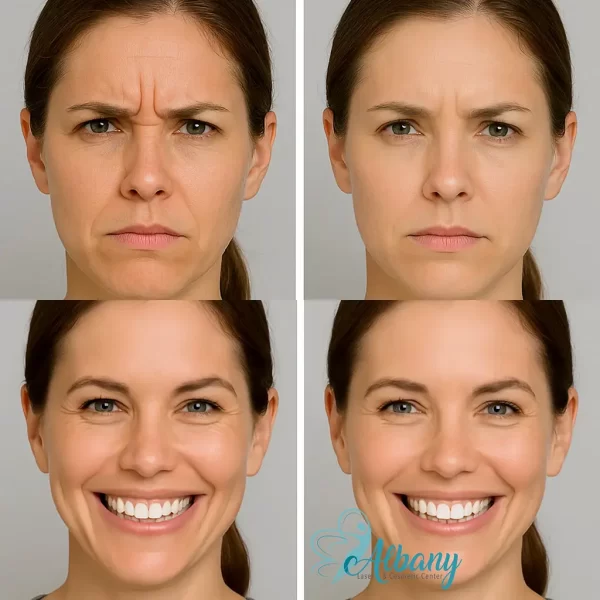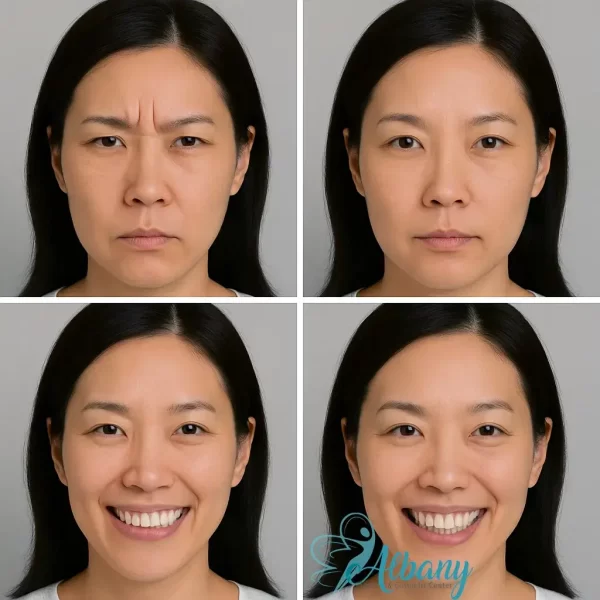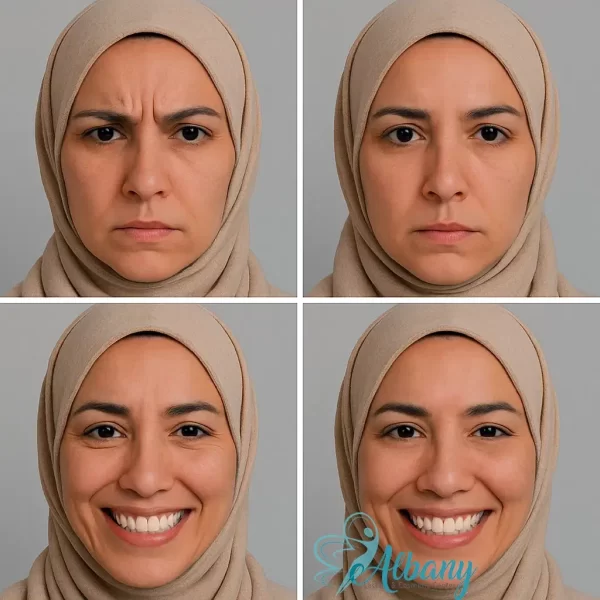Bunny Lines in Edmonton: Causes, Botox Treatment, Aftercare and More
Bunny lines are the fine diagonal wrinkles that appear on either side of the nose when you scrunch or wrinkle your nose. These dynamic lines may be endearing to some, but they can deepen with age and repeated facial expressions. If you’re bothered by the way these nose wrinkles crease your makeup or draw attention away from your eyes, a few carefully placed units of Botox can help smooth them. This page explains what causes bunny lines, how Botox relaxes the muscles that create them, and what to expect before, during and after treatment at Albany Cosmetic & Laser Centre.
Combining Bunny‑Line Treatment with Other Procedures



Many patients choose to address multiple facial concerns in one visit. Bunny‑line Botox pairs well with:
- Frown‑line and forehead injections: Smooth the lines between the brows and across the forehead for a balanced upper face.
- Crow’s‑feet treatment: Relax the orbicularis oculi muscle around the eyes for a brighter look.
- Lip flip or lip fillers: Enhance lip shape and reduce a “gummy” smile while refining nose wrinkles.
- Dermal fillers: Add volume to cheeks, nasolabial folds or temples for comprehensive facial rejuvenation.
- Skin treatments: Combine neuromodulators with chemical peels, microdermabrasion or microneedling to improve skin texture and tone.
Our team will tailor the combination to your goals, ensuring that treatments complement each other and that the timing between procedures is appropriate.
Bunny Lines Treatment Infographic Summary
Cost & Pricing
What To Expect
Mechanism of Action
Benefits & Results
Post-Treatment Care
Side Effects & Downtime
What Are Bunny Lines?
Bunny lines are subtle wrinkles that form at the bridge of the nose, typically extending diagonally down the sides of the nose toward the cheeks. They occur when the nasalis muscle contracts to wrinkle the skin of the nose during facial expressions like smiling, laughing, squinting or sniffing. Over time, repetitive movements and natural loss of skin elasticity make these fine lines more noticeable—even at rest. They are sometimes called “scrunch lines” or “nose wrinkles.”
Why Do Bunny Lines Form?
Several factors contribute to the formation of bunny lines:
- Repeated facial expressions: Scrunching the nose when smiling, laughing or frowning causes the nasalis muscle to contract. Over years of repetition, these motions create etched lines in the skin.
- Strong nasalis muscles: Some people naturally have more active or stronger nasalis muscles, leading to deeper creases on the sides of the nose.
- Age and skin elasticity: As collagen and elastin levels decline with age, the skin becomes thinner and less able to bounce back after movement. This allows dynamic lines to become more pronounced.
- Compensation for other treatments: When Botox relaxes nearby muscles (such as frown lines or crow’s feet), the nasalis sometimes works harder during expressions, accentuating bunny lines.
- Sun damage and lifestyle factors: UV exposure, smoking and repetitive facial movements can all contribute to lines forming more quickly.
How Botox Works for Bunny Lines
Botox is a neuromodulator made from botulinum toxin type A. When injected into the nasalis muscle, it temporarily blocks the nerve signals that cause the muscle to contract. This relaxation smooths the skin on either side of the nose while still allowing natural, subtle movements. Because only a tiny amount of Botox is needed for bunny lines, the rest of your facial expressions remain unaffected.
Benefits of Bunny‑Line Treatment
-
Smooths Nose Wrinkles
Relaxing the nasalis muscle softens diagonal lines on the bridge of the nose, creating a fresher appearance. This subtle improvement can make your smile look more balanced and youthful.
Quick and Convenient
The procedure takes minutes and requires no downtime. You can return to work, run errands or meet friends right after your appointment.
Natural‑Looking Results
When performed by an experienced injector, bunny‑line Botox smooths wrinkles without freezing your facial expressions. Only the targeted muscle is relaxed, so you’ll still be able to move your nose naturally.
Prevents Future Lines
By limiting repetitive muscle contractions, Botox helps prevent existing lines from deepening and reduces the likelihood of new lines forming across your nose.
Why Choose Albany Cosmetic & Laser Centre for Bunny‑Line Botox?
Our clinic combines medical expertise with artistry to deliver subtle, natural‑looking results. Here’s why patients trust us with their bunny‑line treatment:
- Experienced injectors: Our providers have extensive training in facial anatomy and cosmetic neuromodulators, ensuring precise placement and optimal results.
- Personalised approach: We customise the number of units and injection points based on your unique muscle activity and aesthetic goals.
- Comprehensive care: We can treat multiple facial areas during one visit and offer combination therapies for overall facial rejuvenation.
- Safety and comfort: Our medical team follows strict protocols to minimise risk and make the experience as comfortable as possible.
Transparent Pricing
During your consultation, we will recommend the appropriate number of units for your bunny lines, typically 2–4 units per side. Unit pricing ranges from $10–$15. If you combine your treatment with other areas—such as the glabella (frown lines) or crow’s feet—you’ll benefit from package pricing and membership discounts. We’ll provide a detailed quote before any injections are administered.
Frequently Asked Questions
- What exactly are bunny lines?
- Bunny lines are fine diagonal wrinkles on the sides of the nose. They become visible when you scrunch or wrinkle your nose and are caused by repetitive contraction of the nasalis muscle.
- How many units of Botox will I need?
- Most people require just 2–4 units per side to soften bunny lines. Men or individuals with strong nasalis muscles may need slightly more. Your provider will determine the correct dosage during your consultation.
- How much does bunny‑line treatment cost?
- Because only a few units are needed, bunny‑line Botox is one of the most affordable areas to treat. With unit pricing around $10–$15, the total cost typically ranges from $40 to $120, depending on your needs and whether you combine treatments.
- When will I see results and how long do they last?
- You may start to notice smoother nose lines within three to five days. Full results become evident by two weeks and generally last for three to four months. Regular maintenance treatments will keep your nose looking smooth.
- Does the procedure hurt?
- Discomfort is minimal. The injections are performed with a very fine needle and feel like a small pinch. Topical numbing cream can be used if you are particularly sensitive.
- Are there side effects?
- Common side effects include slight redness, swelling or bruising at the injection sites, which usually resolve within a few days. Rare side effects include headache, temporary tenderness or flu‑like symptoms. Serious complications are uncommon when an experienced practitioner administers the injections.
- Can I have bunny‑line Botox along with other treatments?
- Yes. Bunny‑line injections are often combined with treatments for frown lines, forehead lines, crow’s feet or lip enhancements during the same visit. Combining procedures can provide balanced results and may offer cost savings.
- What should I avoid after my appointment?
- For the first 24 hours, avoid pressing or massaging your nose, strenuous exercise, heat exposure (such as saunas or hot yoga), alcohol and smoking. Do not undergo facials, peels or other skin treatments on the same day. Sleep on your back and avoid wearing heavy glasses or anything that puts pressure on the treated area.
- How often should I repeat my treatment?
- Because Botox gradually wears off, most patients return for maintenance every three to four months. You may find that results last longer with regular use as the muscle becomes conditioned to relax.
- Do men develop bunny lines too?
- Yes. Men can develop bunny lines due to strong nasalis muscles or repetitive facial expressions. Treatment is similar for all genders, though men may require slightly more units due to larger muscles.
- Can previous Botox in other areas cause bunny lines?
- In some cases, relaxing the glabella or forehead muscles can cause other muscles to compensate during expression, making bunny lines more noticeable. Treating bunny lines alongside other areas helps balance the face and prevent this effect.
- What if my bunny lines are deep?
- If your bunny lines remain visible at rest or are very deep, combination treatments such as dermal fillers, laser resurfacing or microneedling may be recommended in addition to Botox. We’ll discuss options during your consultation.
- When should I seek medical advice?
- Contact your practitioner if you experience severe pain, difficulty breathing, swallowing or speaking, blurred vision or significant weakness following your treatment. These symptoms are rare but require immediate attention.
Treatment Preparation and Aftercare Timeline
Preparing for Your Bunny‑Line Treatment
To ensure the best results and minimise side effects:
- Avoid blood‑thinning medications and supplements such as aspirin, ibuprofen and vitamin E for 24–48 hours before your appointment, unless directed otherwise by your physician.
- Skip alcohol and smoking in the day leading up to your treatment to reduce bruising and swelling.
- Arrive with a clean face free of makeup, sunscreen or moisturiser.
- Let us know about any recent illnesses, allergies or medications. If you are pregnant or breastfeeding, or have a neuromuscular disorder, neuromodulator treatment may not be recommended.
What to Expect During the Procedure
After a brief consultation to assess your muscle movement, your practitioner will mark the injection points along the sides of your nose. A fine needle delivers tiny amounts of Botox into the nasalis muscle on each side. The process usually takes less than five minutes. Discomfort is minimal and most patients do not require numbing, though a topical anaesthetic can be applied if requested.
Aftercare and Recovery
There’s very little downtime after bunny‑line injections. To promote optimal results and reduce the risk of diffusion:
- Stay upright for at least four hours after your injections. Avoid bending over or lying flat during this time.
- Do not rub, press or massage the treated area for 12–24 hours. Avoid resting eyeglasses, sunglasses or face masks tightly against the nose.
- Avoid strenuous exercise, hot yoga, saunas or steam rooms for 24 hours. Increased blood flow and heat can cause the toxin to spread.
- Skip alcohol and smoking for at least a day after your appointment to minimise bruising and swelling.
- Avoid other facial treatments—such as facials, peels, lasers or microneedling—on the day of your injections.
- If you experience mild swelling or bruising, you can apply a cold compress wrapped in a cloth for 10‑minute intervals. Over‑the‑counter pain relievers like acetaminophen may ease tenderness.
- Results will start to appear within a few days. Do not evaluate the final outcome until two weeks have passed, when the full effect is visible.
- Contact us immediately if you experience unusual symptoms such as severe pain, difficulty breathing, vision changes or muscle weakness.
Who Is a Good Candidate for Bunny‑Line Botox?
Bunny‑line treatment is ideal for adults who:
- Notice diagonal wrinkles at the sides of the nose when they smile, laugh or squint.
- Have dynamic lines caused by muscle activity, rather than static wrinkles or deep creases that remain at rest.
- Are in good general health and not pregnant or breastfeeding.
- Have no history of neuromuscular disorders or allergies to botulinum toxin.
- Understand that results are temporary and require maintenance every three to four months.
Individuals with severe nasal wrinkling due to skin laxity or structural issues may need combination treatments such as fillers or laser resurfacing. We’ll assess your facial anatomy during your consultation and recommend the most appropriate plan.
Read our privacy policy here